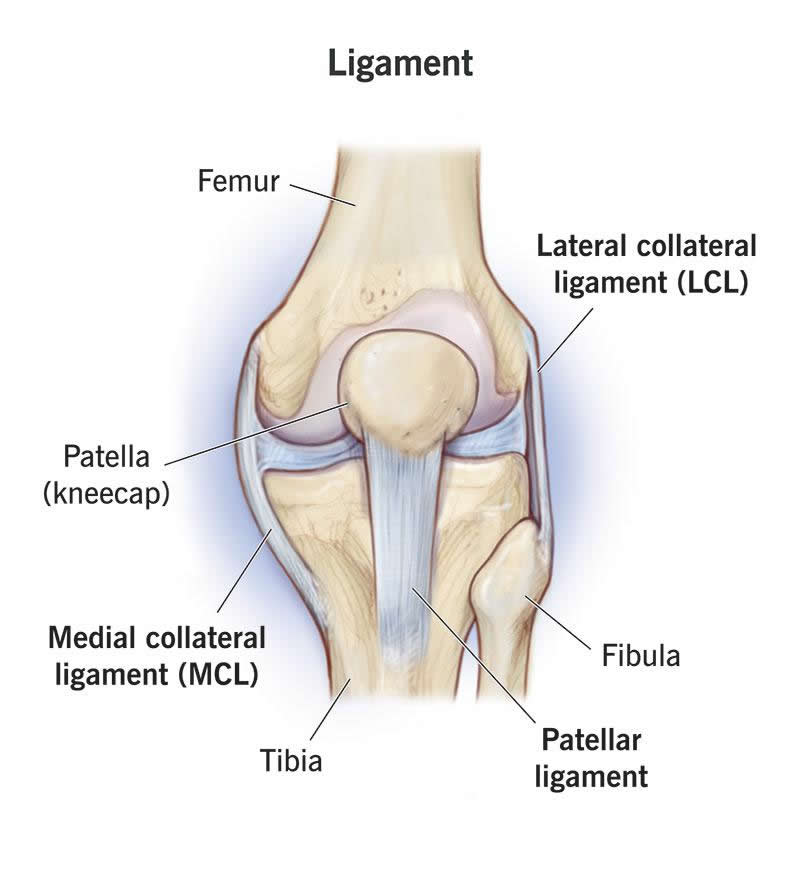Ligament
Ligaments are connective tissues that join bones to other bones. There are over 900 ligaments in your body. A sprain is a common injury that happens when you overstretch or tear a ligament. Most ligament injuries are accidents, but exercise can help keep your ligaments strong and less prone to injury.
Overview

What is a ligament?
Ligaments are tough, fibrous bands of connective tissue in your body. They connect bones to other bones and help hold important body structures in place, including joints and some organs. These cord-like tissues are mostly composed of collagen and elastin, which makes them strong but flexible.
Function
What do ligaments do?
Ligaments hold bones and other body parts together in a way that allows for a limited amount of movement. They give a little, but also prevent parts from moving too much or moving the wrong way.
They:
- Connect bones to bones and hold your skeleton together
- Bind the ends of bones together in a joint and allow them to move in certain ways
- Reinforce joints and prevent them from twisting or dislocating
- Hold organs like your small intestine, liver, stomach and uterus in place
Anatomy
Where are my ligaments?
There are more than 900 ligaments in your body. Many of them are in your limbs, especially in your articulating joints. Some connect muscles to bones and support large organs in your abdominal cavity.
Some of your important ligaments include your:
- Ankle ligaments. These hold your ankle joint together and allow it to articulate.
- Foot ligaments. These help support the structure of your foot as it flexes under pressure.
- Knee ligaments. These connect your leg bones and hold your knee joint together.
- Inguinal ligaments. These connect your abdominal muscles to your bony pelvis.
- Median arcuate ligament. This arched ligament connects your diaphragm to your spine.
- Round ligaments. These support your pelvic organs, including your uterus from either side.
- Shoulder ligaments. Ligaments supporting your shoulder joint can stretch, tear or separate.
- Uterosacral ligaments. These connect the lower part of your uterus to the base of your spine.
- Wrist ligaments. Ligaments in your wrist joint can tear or stretch if you fall on your hand.
What do ligaments look like?
Ligaments come in different shapes and sizes. Most look like ropes, cords or bands. Some are thin, like string, while others are wider. Some are even shaped in an arch. They can be pink, yellow or white.
What are the parts of a ligament?
Ligament parts include:
- Protein fibers. Ligaments are mostly made up of woven strands of proteins, especially collagen and elastin. Some have more collagen for toughness, and others have more elastin for elasticity. When forces put stress on your ligaments, some strands appear to tighten while others loosen.
- Epiligament. Some ligaments have an outer layer called an epiligament. This layer has many more blood vessels and nerves in it than the inner part. It seems to play an important role in detecting and repairing injuries to your ligament. Blood vessels feed the tissues as they repair.
Conditions and Disorders
How do you injure a ligament?
You can sprain a ligament by pulling it too hard or forcing it to move in the wrong direction. This stretches or tears the ligament fibers apart. Sprains often happen during a sudden fall, twist or impact.
Some common ligament injuries include:
- Ankle sprains
- Back sprains
- Knee sprains (including ACL, PCL, LCL and MCL tears)
- Round ligament pain (during pregnancy)
- Scapholunate dissociation (in your wrist)
- Sprained finger or thumb
- Ulnar collateral ligament injury (in your elbow)
Care
How can I keep my ligaments healthy?
As you age, your ligaments can start to weaken and become more likely to be injured. You can help keep your ligaments healthy and strong by getting some regular exercise and avoiding sitting too much. Don’t forget to warm up and stretch before exercising. Make sure to ease up when you feel pain or strain.
Eating certain nutrients can also help nourish your ligaments, including:
- Manganese (found in nuts, legumes, seeds, whole grains and leafy green vegetables)
- Omega-3s (found in fish, flaxseeds and chia seeds and oils)
- Cruciferous vegetables (like broccoli, cauliflower, leafy greens, cabbages, garlic and onions)
- Vitamin A (found in carrots, sweet potatoes, peaches, apricots and fortified dairy products)
- Vitamin C (found in citrus fruits, strawberries, cantaloupe, red peppers and potatoes)
A note from Wockr
Ligaments are tough, but when they tear, they can take a long time to heal. Afterward, they’re never quite as strong as before. A sprain can leave your joint unstable and more prone to sprain again. You’ll need to take extra care to protect it from further injury in the future, especially if you’re an athlete.
If you think you may have pulled a ligament, call a healthcare provider. They’ll assess the injury and make a plan to support the healing process. Some tears might need surgery, while others might need weeks or months of rest to heal. After that, physical therapy can help rehabilitate your ligament.